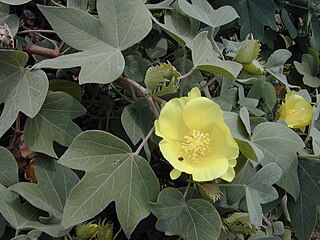
Gossypium is a genus of flowering plants in the tribe Gossypieae of the mallow family, Malvaceae, from which cotton is harvested. It is native to tropical and subtropical regions of the Old and New Worlds. There are about 50 Gossypium species, making it the largest genus in the tribe Gossypieae, and new species continue to be discovered. The name of the genus is derived from the Arabic word goz, which refers to a soft substance.

Gossypium hirsutum, also known as upland cotton or Mexican cotton, is the most widely planted species of cotton in the world. Globally, about 90% of all cotton production is of cultivars derived from this species. In the United States, the world's largest exporter of cotton, it constitutes approximately 95% of all cotton production. It is native to Mexico, the West Indies, northern South America, Central America and possibly tropical Florida.

Gossypium tomentosum, commonly known as maʻo, huluhulu or Hawaiian cotton, is a species of cotton plant that is endemic to the Hawaiian Islands. It inhabits low shrublands at elevations from sea level to 120 m (390 ft). Maʻo is a shrub that reaches a height of 1.5–5 ft (0.46–1.52 m) and a diameter of 5–10 ft (1.5–3.0 m). The seed hairs (lint) are short and reddish brown, unsuitable for spinning or twisting into thread.
Meloidogyne acronea, the African cotton root-knot nematode or African cotton root nematode, is a plant pathogenic nematode affecting pigeonpeas. It is also an invasive species. The roots and surrounding soils of cereals, grasses, and Gossypium spp. provide habitat for this organism. M. acronea was confirmed as a potentially problematic pest of cotton, Gossypium hirsutum cv. Makoka, which was proven through pot experiments.
Novosphingobium is a genus of Gram-negative bacteria that includes N. taihuense, which can degrade aromatic compounds such as phenol, aniline, nitrobenzene and phenanthrene. The species N. aromativorans, which was first found in Ulsan Bay, similarly degrades aromatic molecules of two to five rings.

Earias perhuegeli, the rough bollworm, is a moth of the family Nolidae. The species was first described by Jeremy Daniel Holloway in 1977. It is found in the northern two-thirds of Australia and several islands in the South Pacific.
Bucculatrix gossypii is a moth of the family Bucculatricidae. It is found in Queensland, Australia. The species was described in 1926 by Alfred Jefferis Turner.
Acrocercops gossypii is a moth of the family Gracillariidae. It is known from South Africa.
Novosphingobium arabidopsis is a Gram-negative, rod-shaped and aerobic bacterium from the genus Novosphingobium which has been isolated from the rhizosphere of the plant Arabidopsis thaliana. Novosphingobium arabidopsis is resistant against dichlorodiphenyltrichloroethane (DDT).
Novosphingobium chloroacetimidivorans is a Gram-negative, chloroacetamide-degrading and non-spore-forming bacterium from the genus Novosphingobium which has been isolated from activated sludge from a wastewater treatment plant in Kunshan City in China.
Novosphingobium indicum is a bacterium from the genus Novosphingobium which has been isolated from deep-sea water from the Indian Ocean. Novosphingobium indicum has the ability to degrade polycyclic aromatic hydrocarbon.
Novosphingobium lentum is a Gram-negative, rod-shaped, non-spore-forming, psychrotolerant and non-motile bacterium from the genus Novosphingobium which has been isolated from chlorophenol-contaminated groundwater in Finland. Novosphingobium lentum has the ability to degrade chlorophenol.
Novosphingobium marinum is a Gram-negative, aerobic and short rod-shaped bacterium from the genus Novosphingobium which has been isolated from sea water from the Pacific Ocean.
Novosphingobium rhizosphaerae is a Gram-negative, non-spore-forming and rod-shaped bacterium from the genus Novosphingobium which has been isolated from the rhizosphere of the corn plant Zea mays in Tallassee, Alabama in the United States.
Novosphingobium sediminicola is a Gram-negative, short rod-shaped, non-spore-forming and non-motile bacterium from the genus Novosphingobium which has been isolated from freshwater sediments from the Lake Hakha in Korea.
Novosphingobium soli is a Gram-negative, rod-shaped and non-spore-forming bacterium from the genus Novosphingobium which has been isolated from oil-contaminated soil near an oil refinery in Kaohsiung County in Taiwan.
Novosphingobium taihuense is a bacterium from the genus Novosphingobium which has been isolated from lake sediments from the Taihu Lake in China. Novosphingobium taihuense has the ability to degrade phenol, aniline, nitrobenzene, 4-chloronitrobenzene and phenanthrene.
Variovorax gossypii is a Gram-negative and small rod-shaped bacterium from the genus of Variovorax which has been isolated from the plant Gossypium hirsutum from Tallassee in the United States.
Saccharibacillus endophyticus is a Gram-positive, facultatively anaerobic and endospore-forming bacteria from the genus of Saccharibacillus which has been isolated from the plant Gossypium hirsutum.
Amanda M. Hulse-Kemp is a computational biologist with the United States Department of Agriculture – Agricultural Research Service. She works in the Genomics and Bioinformatics Research Unit and is stationed on the North Carolina State University campus in Raleigh, North Carolina.



